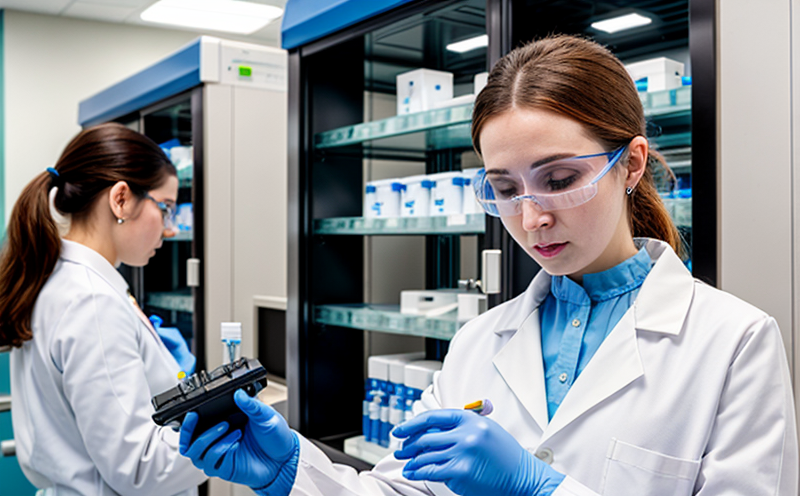Microdialysate Bioanalysis Testing
The Microdialysate Bioanalysis Testing service is a critical tool in the pharmaceutical industry, specifically for the development and quality assurance of drugs aimed at treating neurological disorders. This method involves the sampling of extracellular fluids from living tissue to assess drug distribution, metabolism, and pharmacokinetics. The procedure entails inserting a microdialysis probe into brain tissue or other relevant tissues, which continuously collects fluid samples over time.
The collected microdialysate is then analyzed using various techniques such as high-performance liquid chromatography (HPLC), mass spectrometry (MS), and capillary electrophoresis. This testing ensures that the drug's concentration in the extracellular space aligns with therapeutic goals, enabling researchers to fine-tune dosage levels and identify potential side effects early on.
Microdialysate bioanalysis is particularly useful for drugs targeting the central nervous system (CNS), where traditional blood sampling methods may not provide accurate representation of drug distribution. By directly measuring drug concentrations in the extracellular space, this testing offers a more precise understanding of how medications interact with their target tissues.
The process begins with careful preparation and insertion of the microdialysis probe into the desired tissue site. Once in place, it is left to function over several hours or days, depending on the study design. During this time, the probe collects small volumes of extracellular fluid, which are then analyzed for drug presence and concentration.
The reliability of Microdialysate Bioanalysis Testing is underscored by its adherence to international standards such as ISO 17025, ensuring that laboratories performing these tests meet stringent quality requirements. The method's precision allows researchers to make informed decisions about dosage adjustments and potential modifications to the drug formulation.
One of the key advantages of this testing approach is its ability to provide real-time data on drug distribution within tissues. This capability is particularly valuable in CNS research, where understanding how drugs behave at the cellular level can lead to breakthroughs in treatment efficacy. Additionally, Microdialysate Bioanalysis Testing helps identify potential issues early in development, reducing the likelihood of costly late-stage failures.
To ensure accurate and consistent results, laboratories must adhere to strict protocols for specimen preparation and analysis. This includes precise calibration of instruments, regular maintenance of equipment, and adherence to standardized methods outlined by relevant bodies like ASTM International and IEC. The use of advanced instrumentation such as ultra-performance liquid chromatography (UPLC) further enhances the accuracy and sensitivity of these tests.
The Microdialysate Bioanalysis Testing method is not only essential for drug development but also plays a crucial role in ensuring patient safety by identifying potential side effects or interactions. By providing detailed insights into how drugs behave within their intended target tissues, this testing helps refine therapeutic strategies and optimize treatment protocols.
Why It Matters
Microdialysate Bioanalysis Testing is vital for several reasons. Firstly, it offers a more accurate representation of drug behavior within tissues compared to traditional blood sampling methods. This accuracy is particularly important in CNS research, where understanding how drugs interact with neural tissue can lead to significant advancements in treatment efficacy.
- Enhances the precision of drug distribution measurements
- Identifies potential side effects early in development
- Optimizes therapeutic strategies and treatment protocols
- Aids in refining dosage levels for optimal performance
The reliability of this testing method is further enhanced by its adherence to international standards such as ISO 17025, ensuring that laboratories performing these tests meet stringent quality requirements. This commitment to accuracy and consistency contributes significantly to the overall success of pharmaceutical research and development.
Why Choose This Test
- Provides real-time data on drug distribution within tissues
- Enables precise dosage adjustments for optimal performance
- Aids in the identification of potential side effects early in development
- Supports the refinement of therapeutic strategies and treatment protocols
The Microdialysate Bioanalysis Testing method is particularly advantageous for CNS research, where understanding how drugs behave at the cellular level can lead to significant advancements. By offering detailed insights into drug interactions within their intended target tissues, this testing helps optimize treatment efficacy and patient safety.
Use Cases and Application Examples
| Use Case | Description |
|---|---|
| CNS Drug Development | Assessment of drug distribution, metabolism, and pharmacokinetics in brain tissue. |
| Prediction of Side Effects | Evaluation of potential side effects early in development to mitigate risks. |
| Treatment Optimization | Refinement of therapeutic strategies and optimization of treatment protocols for CNS disorders. |
| Dosage Adjustment | Precision measurement of drug concentrations to fine-tune dosage levels. |
| Safety Evaluation | Identification of potential safety issues through detailed analysis of extracellular fluid samples. |
| Treatment Efficacy | Evaluation of treatment efficacy by monitoring drug distribution and metabolism in real-time. |
The Microdialysate Bioanalysis Testing method finds extensive application in CNS research, where understanding how drugs behave at the cellular level can lead to significant advancements. By offering detailed insights into drug interactions within their intended target tissues, this testing helps optimize treatment efficacy and patient safety.





